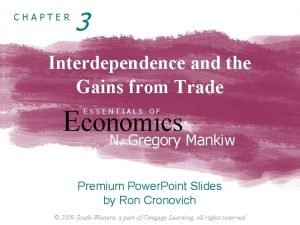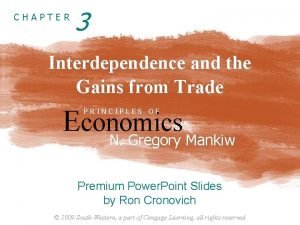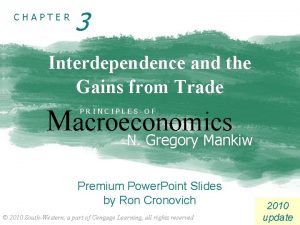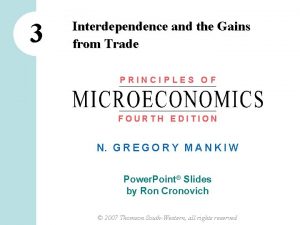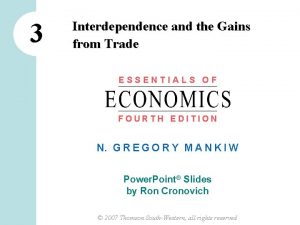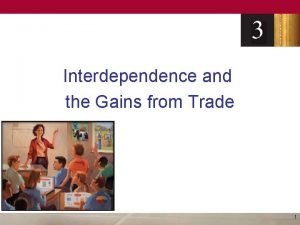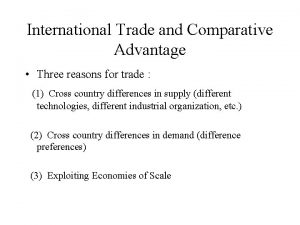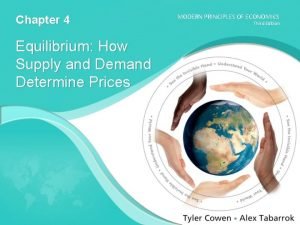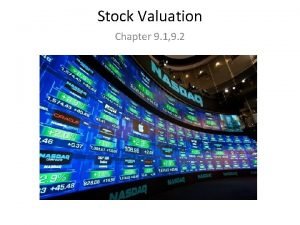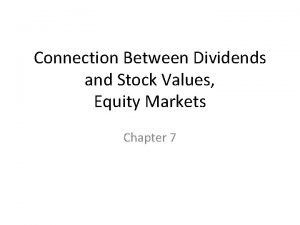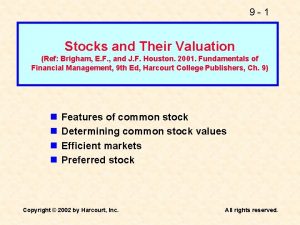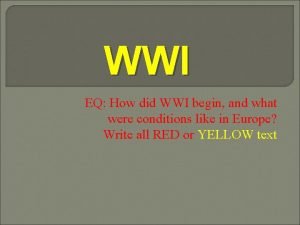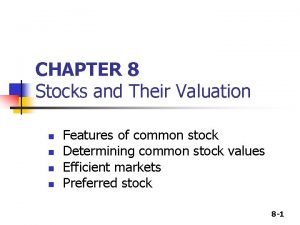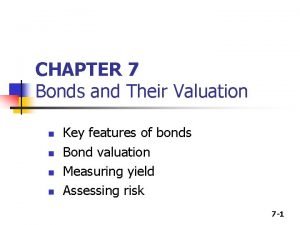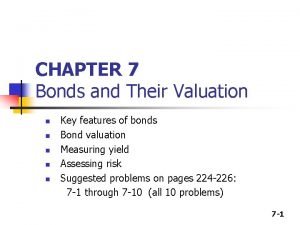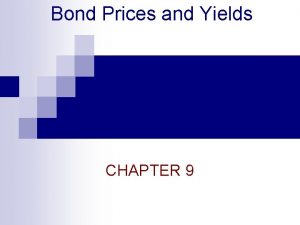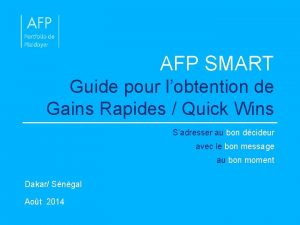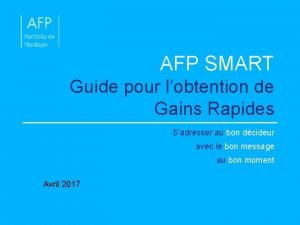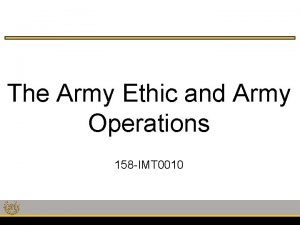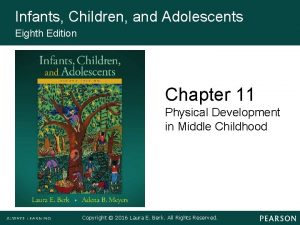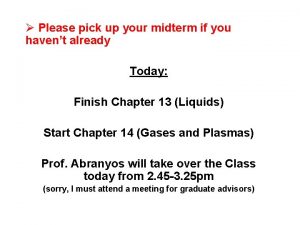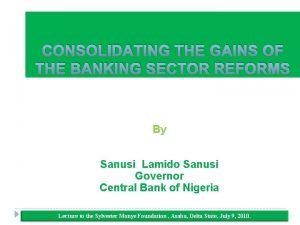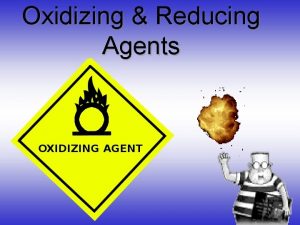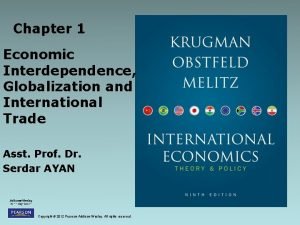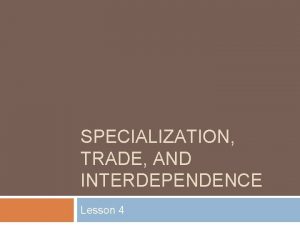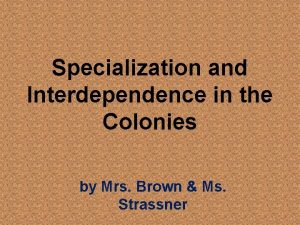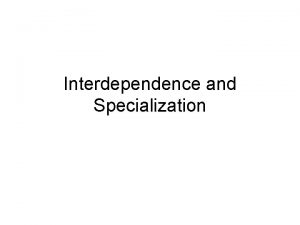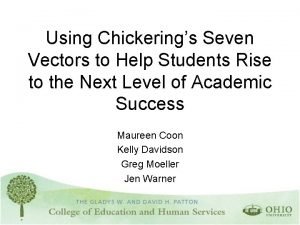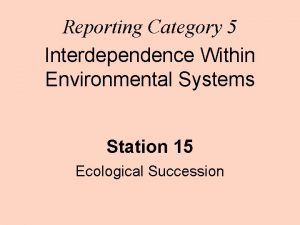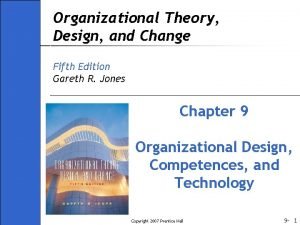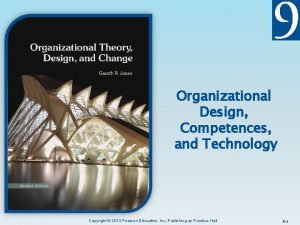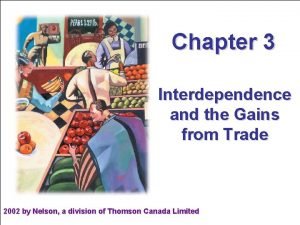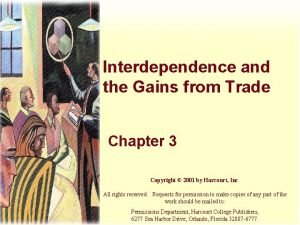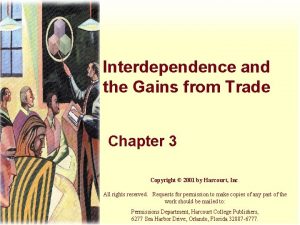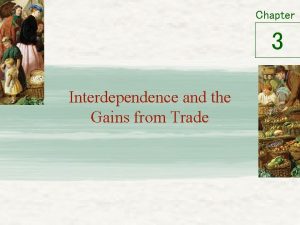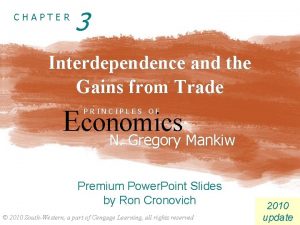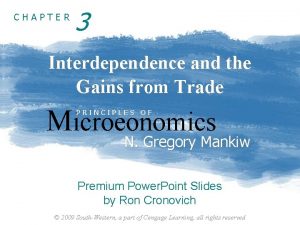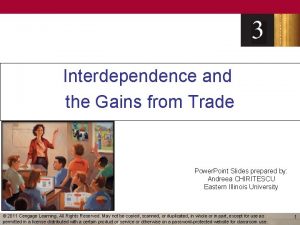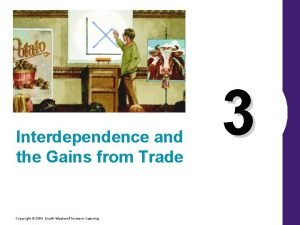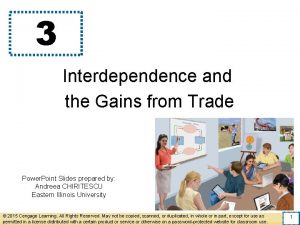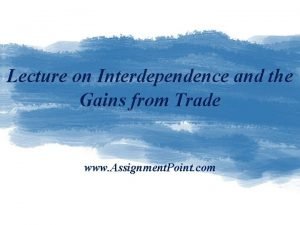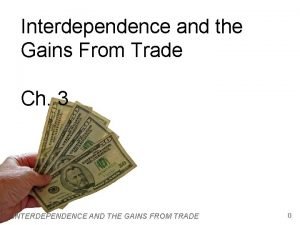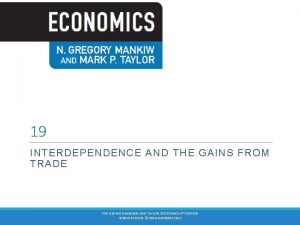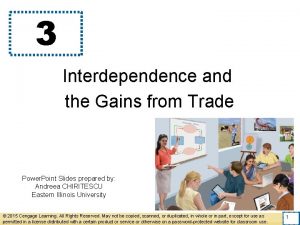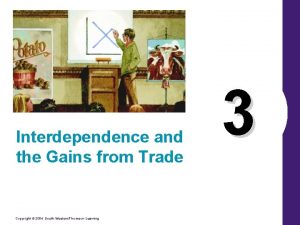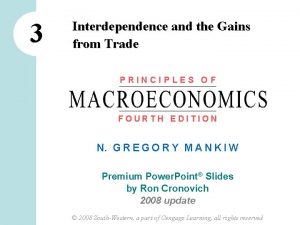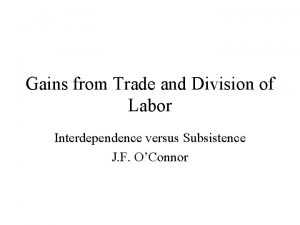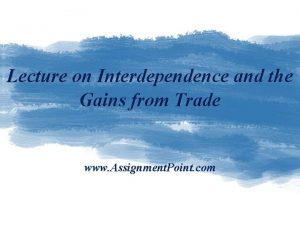Chapter 3 Interdependence and the Gains From Trade














































- Slides: 46

Chapter 3: Interdependence and the Gains From Trade ECO 10 Intro to Microeconomics Udayan Roy

Why Should We Study Trade? • People trade with each other – Do you know anyone who makes all the things he or she consumes? • To understand our world we need to understand why people trade so much • We need to understand whether trade is good for us or bad for us. – Understanding this is important precisely because we trade a lot. CHAPTER 3 INTERDEPENDENCE AND THE GAINS FROM TRADE 2

A Parable For The Modern Economy • Imagine a world with … – only two goods: potatoes and meat – only two people: a potato farmer and a cattle rancher • What amounts should each produce? • Should they trade? CHAPTER 3 INTERDEPENDENCE AND THE GAINS FROM TRADE 3

By the way… • Q: Why am I assuming a world with only two goods and two people? • A: Simplicity is often key to clarifying an idea • Q: Okay, but in that case why not assume a world with just one good and/or one person? CHAPTER 3 INTERDEPENDENCE AND THE GAINS FROM TRADE 4

Opportunity cost • In our story, the farmer can produce both meat and potatoes • However, as the farmer has a finite amount of the resources needed for production, the production of an additional ounce of meat necessarily reduces the quantity of potatoes the farmer can produce • The reduction in potato production caused by the production of an additional ounce of meat is called the opportunity cost of meat CHAPTER 3 INTERDEPENDENCE AND THE GAINS FROM TRADE 5

Opportunity cost • In our story, the farmer’s opportunity cost of producing an additional ounce of meat is the unavoidable reduction in his production of potatoes • Can you apply the concept of opportunity cost to your own life? – List all the activities you normally engage in every day – Think about the sacrifices you will have to make if you were to enroll in an additional economics course – That’s your opportunity cost of taking an additional economics course this semester CHAPTER 3 INTERDEPENDENCE AND THE GAINS FROM TRADE 6

Opportunity cost and trade • Suppose the opportunity cost of an ounce of meat is 3 ounces of potatoes for both Farmer and Rancher • Will they trade? • No. Trade would be pointless in this case. Opportunity Costs Meat Potatoes Farmer 3 1/3 Rancher 3 1/3 CHAPTER 3 INTERDEPENDENCE AND THE GAINS FROM TRADE By the way, can you fill in the blank cells in the table? 7

Opportunity cost and trade • Now will they trade? • Yes! – Rancher will offer to sell meat to farmer at a price between 2 and 4 ounces of potatoes per ounce of meat – Farmer will gladly accept – Both farmer and rancher will be better off Opportunity Costs Meat Potatoes Farmer 4 1/4 Rancher 2 1/2 4 2 Again, can you fill in the blank cells in the table? 8

Opportunity cost and trade • Therefore, we have just seen that opportunity cost is key to understanding virtually every aspect of trade – If opportunity costs are equal, there will be no trade – If opportunity costs are different, there will be trade – The price at which the trading occurs will be somewhere between the two traders’ opportunity costs – The person with the lower opportunity cost of meat will be the meat seller (exporter) and potato buyer • This person is said to have a comparative advantage in meat production – The person with the higher opportunity cost of meat will be the meat buyer (importer) and potato seller CHAPTER 3 INTERDEPENDENCE AND THE GAINS FROM TRADE 9

Opportunity cost and trade • Trade makes people specialize in the production of the good they have a comparative advantage in • Rancher has a comparative advantage in producing meat. • Trade gives the rancher the incentive to expand meat production for sale (export) to the farmer • That is, trade gives the rancher the incentive to specialize in what he does best Opportunity Costs 4 2 Meat Potatoes Farmer 4 ¼ Rancher 2 ½ ½ ¼ 10

Opportunity costs • We have just seen that opportunity costs are key to trade • What makes opportunity costs vary from person to person or from country to country? • One answer is technology: – different people may have different technologies – and this causes them to have different opportunity costs – Let us now see an example of this … CHAPTER 3 INTERDEPENDENCE AND THE GAINS FROM TRADE 11

Production Technologies of the Farmer and Rancher These technology numbers can be used to calculate opportunity costs 12

Opportunity Costs of Farmer • 1 ounce of meat → 60 minutes → 4 ounces of potatoes. • Therefore, Farmer’s opportunity cost of 1 ounce of meat is 4 ounces of potatoes. Minutes Needed to Make 1 Ounce of: Opportunity Costs Meat Potatoes Farmer 60 min/oz 15 min/oz Farmer Rancher 20 min/oz 10 min/oz Rancher Meat 4 Potatoes

Opportunity Costs of Farmer • 1 ounce of potatoes → 15 minutes → ¼ ounces of meat. • Therefore, Farmer’s opportunity cost of 1 ounce of potatoes is ¼ ounces of meat. Minutes Needed to Make 1 Ounce of: Opportunity Costs Meat Potatoes Farmer 60 min/oz 15 min/oz Farmer Rancher 20 min/oz 10 min/oz Rancher Meat Potatoes 4 ¼

Opportunity Costs of Rancher • 1 ounce of meat → 20 minutes → 2 ounces of potatoes. • Therefore, Rancher’s opportunity cost of 1 ounce of meat is 2 ounces of potatoes. Minutes Needed to Make 1 Ounce of: Meat Potatoes Farmer 60 min/oz 15 min/oz Rancher 20 min/oz 10 min/oz Opportunity Costs Meat Potatoes Farmer 4 ¼ Rancher 2

Opportunity Costs of Rancher • 1 ounce of potatoes → 10 minutes → ½ ounces of meat. • Therefore, Rancher ’s opportunity cost of 1 ounce of potatoes is ½ ounces of meat. Minutes Needed to Make 1 Ounce of: Meat Potatoes Farmer 60 min/oz 15 min/oz Rancher 20 min/oz 10 min/oz Opportunity Costs Meat Potatoes Farmer 4 ¼ Rancher 2 ½

Opportunity Costs and Comparative Advantage • It follows that, – Farmer has a comparative advantage in potatoes and – Rancher has a comparative advantage in meat. Table 1 Opportunity Costs Meat Potatoes Farmer 4 ¼ Rancher 2 ½ 17

Technological differences are an important reason why we trade • To sum up, we have so far seen that – Trade happens if and only if opportunity costs vary from person to person (or from country to country) – Differences in technological abilities can lead to differences in opportunity costs CHAPTER 3 INTERDEPENDENCE AND THE GAINS FROM TRADE 18

Absolute Advantage and Comparative Advantage • If Farmer can make an ounce of potatoes in less time than Rancher needs to do the same, then Farmer is said to have an absolute advantage in making potatoes • On the other hand, as we have seen already, if Farmer can make an ounce of potatoes at a lower opportunity cost than Rancher can, then Farmer is said to have a comparative advantage in making potatoes CHAPTER 3 INTERDEPENDENCE AND THE GAINS FROM TRADE 19

Absolute Advantage and Comparative Advantage • At one point, economists thought that two people would trade if and only if each had an absolute advantage in the production of some commodity. • David Ricardo, a nineteenth-century British economist, later showed that absolute advantage is irrelevant. • Two people would trade if and only if each had a comparative advantage in the production of some commodity. CHAPTER 3 INTERDEPENDENCE AND THE GAINS FROM TRADE 20

Technology and Opportunity Costs Rancher has an absolute advantage in both goods. Farmer has a comparative advantage in potatoes. Rancher has a comparative advantage in meat. Trade will happen. Farmer will export potatoes and Rancher will export meat. Minutes Needed to Make 1 Ounce of: Meat Potatoes Farmer 60 min/oz 15 min/oz Rancher 20 min/oz 10 min/oz Opportunity Costs Meat Potatoes Farmer 4 ¼ Rancher 2 ½

Technology and Opportunity Costs Rancher has an absolute advantage in meat. Farmer has an absolute advantage in potatoes. Farmer has a comparative advantage in potatoes. Rancher has a comparative advantage in meat. Trade will happen. Farmer will export potatoes and Rancher will export meat. Minutes Needed to Make 1 Ounce of: Meat Potatoes Farmer 60 min/oz 15 min/oz Rancher 40 min/oz 20 min/oz Opportunity Costs Meat Potatoes Farmer 4 ¼ Rancher 2 ½

Technology and Opportunity Costs Farmer has an absolute advantage in both goods. Farmer has a comparative advantage in potatoes. Rancher has a comparative advantage in meat. Trade will happen. Farmer will export potatoes and Rancher will export meat. Minutes Needed to Make 1 Ounce of: Meat Potatoes Farmer 60 min/oz 15 min/oz Rancher 400 min/oz 200 min/oz Opportunity Costs Meat Potatoes Farmer 4 ¼ Rancher 2 ½

But Differences Can’t be the Whole Story • Why is Canada our main trade partner despite being so similar to the US? CHAPTER 3 INTERDEPENDENCE AND THE GAINS FROM TRADE 24

Other Reasons Why Trade Is Good for Us • Trade allows us to fully utilize the benefits of bulk production by allowing each country’s production to be sold everywhere. • Trade intensifies competition and squeezes out inefficient production. CHAPTER 3 INTERDEPENDENCE AND THE GAINS FROM TRADE 25

Exercise: calculation of opportunity costs from technology • We have seen how opportunity Table 1 costs can be calculated from the 2 nd and 3 rd columns (blue border) of the technology table below • But can you do it using the 4 th and Farmer 5 th columns (brown border) Rancher instead? Opportunity Costs Meat Potatoes

GRAPHING PRODUCTION POSSIBILITIES CHAPTER 3 INTERDEPENDENCE AND THE GAINS FROM TRADE 27

Rancher’s Production Possibilities: Further Details Time Spent on Production of… Amount Produced Meat Potatoes 0 8 0 48 2 6 6 36 4 4 12 24 6 2 18 12 8 0 24 0 CHAPTER 3 INTERDEPENDENCE AND THE GAINS FROM TRADE 28

Figure 1 The Rancher’s Production Possibilities Frontier (b) The Rancher ’s Production Possibilities Frontier Meat (ounces) 24 18 If there is no trade, the rancher might choose this production and consumption. C Amount Produced Meat Potatoes 0 48 6 36 12 24 18 12 24 0 B 12 6 0 12 24 36 48 Potatoes (ounces) CHAPTER 3 INTERDEPENDENCE AND THE GAINS FROM TRADE 29

The Production Possibilities Frontier • If either person increases his production of meat, his production of potatoes must decrease. • When there is no trade, each person must consume what he produces. • In that case, if either person increases his consumption of meat, his consumption of potatoes must decrease. CHAPTER 3 INTERDEPENDENCE AND THE GAINS FROM TRADE 30

Farmer’s Production Possibilities Time spent on production of… Amount Produced Meat Potatoes 0 8 0 32 2 6 2 24 4 16 6 2 6 8 8 0 CHAPTER 3 INTERDEPENDENCE AND THE GAINS FROM TRADE 31

Figure 1 The Farmer’s Production Possibilities Frontier (a) The Farmer ’s Production Possibilities Frontier Meat (ounces) Amount Produced 2. If the farmer wants more meat, he can go from A to B. 8 If there is no trade, the farmer might choose this production and consumption. B 3. Gain 4 ounces of meat A 4 4. Lose 16 ounces of potatoes 5. The opportunity cost of 1 ounce of meat is, therefore, 4 ounces of potatoes. 0 8. Lose 4 ounces of meat 16 6. If the farmer wants more potatoes, he can go from A to C. 7. Gain 16 ounces of potatoes Meat Potatoes 0 32 2 24 4 16 6 8 8 0 C 32 Potatoes (ounces) 9. The opportunity cost of 1 ounce of potatoes is therefore ¼ ounces of meat

The Production Possibilities Frontier Can Shift (a) The Farmer ’s Production Possibilities Frontier Meat (ounces) If more or better resources become available or if more advanced technology becomes available, the PPC will move outward. In that case it might be possible to produce more of both goods, as in the move from A to B. 8 B A 4 0 16 32 Potatoes (ounces) CHAPTER 3 INTERDEPENDENCE AND THE GAINS FROM TRADE 33

More Meat and More Potatoes? • It may be possible to increase one’s consumption of both meat and potatoes—as in the last slide—if… – More resources or better resources become available, or – Technology becomes more advanced, or – Farmer and Rancher begin to trade CHAPTER 3 INTERDEPENDENCE AND THE GAINS FROM TRADE 34

More Meat and More Potatoes? • Trade can increase the overall production—and consumption—of both goods even if resources and technology remain unchanged. • This is the miracle of trade. CHAPTER 3 INTERDEPENDENCE AND THE GAINS FROM TRADE 35

The Production Possibilities Frontier • The production possibilities frontier is a graph that shows the combinations of output that the economy can produce, given – the available factors (resources) of production and – the available production technology. • This and the next three slides are from Chapter 2. CHAPTER 3 INTERDEPENDENCE AND THE GAINS FROM TRADE 36

The Production Possibilities Frontier Quantity of Computers Produced This PPF illustrates Increasing Opportunity Costs or Diminishing Returns: as production of a commodity increases, so does its opportunity cost 3, 000 E C A 2, 200 2, 000 From E to A, the opp. cost of a car is (3000 – 2200)/600 = 1. 33 From A to B, the opp. cost of a car is (2200 – 2000)/(700 – 600) = 2 B From B to F, the opp. cost of a car is 2000/(1000 – 700) = 6. 67 D 1, 000 0 300 600 700 F 1, 000 Quantity of Cars Produced

The Production Possibilities Frontier • Concepts illustrated by the production possibilities frontier – Efficiency – Trade-offs – Opportunity cost – Economic growth CHAPTER 3 INTERDEPENDENCE AND THE GAINS FROM TRADE 38

A Shift in the Production Possibilities Frontier Quantity of Computers Produced 4, 000 Can trade alone take us from A to G? 3, 000 2, 300 2, 200 0 G A 600 650 of 1, 000 Cars. Quantity Produced 39

REVISITING THEORY OF COMPARATIVE ADVANTAGE CHAPTER 3 INTERDEPENDENCE AND THE GAINS FROM TRADE 40

Why Is Trade Good for Us? • Trade benefits both the Farmer and the Rancher by enabling each person to do only what he is better suited to do. • Imagine what it would be like if you were required to produce everything that you needed. • The situation would be similarly awful for a country that either chose not to trade with other countries or was forced to end all trade with other countries. – There additional reasons why trade is good for us. Those reasons will be briefly discussed later. CHAPTER 3 INTERDEPENDENCE AND THE GAINS FROM TRADE 41

Theory of Comparative Advantage • Theory of Comparative Advantage says that if each person specializes in producing what he or she has a comparative advantage in, then total production of every good can increase and, • As a result, trade can benefit everybody. • In our example, theory says that if Farmer specializes in potatoes and Rancher specializes in meat, the total production of meat can be increased and the total production of potatoes can also be increased. • As a result, if Rancher and Farmer then trade, they could both benefit. • But is theory true? CHAPTER 3 INTERDEPENDENCE AND THE GAINS FROM TRADE 42

Theory of Comparative Advantage—Proof • Suppose Farmer increases his production of potatoes by 4 ounces. • Then, according to Table 1, his production of meat must decrease by 1 ounce. • Suppose Rancher increases his production of meat by 1. 5 ounces. Then his production of potatoes must decrease by 3 ounces. • Therefore, by making these two people specialize according to their comparative advantages, it is possible to increase the total output of meat by 0. 5 ounces and of potatoes by 1 ounce. Table 1 Opportunity Costs Meat Potatoes Farmer 4 ¼ Rancher 2 ½ 43

Wow! • We have just witnessed a miracle—the miracle of trade. For an individual, it is impossible to make more of one good without making less of some other good. But for the world as a whole, it is possible to produce more of all goods simultaneously if we embrace trade. Farmer Rancher Total Change in Production Potatoes Meat +4 -1 -3 +1. 5 +1 +0. 5 44

The Legacy of Adam Smith and David Ricardo • Adam Smith In his 1776 book An Inquiry into the Nature and Causes of the Wealth of Nations, Adam Smith performed a detailed analysis of trade and economic interdependence, which economists still adhere to today. • David Ricardo In his 1816 book Principles of Political Economy and Taxation, David Ricardo developed the principle of comparative advantage as we know it today. CHAPTER 3 INTERDEPENDENCE AND THE GAINS FROM TRADE 45

Terms of Trade • In showing how trade can make Farmer and Rancher better off, I worked out an example of how trade could occur. – Specifically, I showed that if 1. 25 ounces of meat are traded for 3. 5 ounces of potatoes, both Farmer and Rancher would be better off. • But will trade take place? • And if it does, at what price will people trade? • That’s the subject of the next chapter. CHAPTER 3 INTERDEPENDENCE AND THE GAINS FROM TRADE 46
 Interdependence and the gains from trade
Interdependence and the gains from trade Interdependence and the gains from trade chapter 3
Interdependence and the gains from trade chapter 3 Interdependence and the gains from trade
Interdependence and the gains from trade Interdependence and the gains from trade chapter 3
Interdependence and the gains from trade chapter 3 Chapter 3 interdependence and the gains from trade summary
Chapter 3 interdependence and the gains from trade summary Chapter 3 interdependence and the gains from trade
Chapter 3 interdependence and the gains from trade Interdependence and the gains from trade
Interdependence and the gains from trade Gains from trade
Gains from trade How to calculate unexploited gains from trade
How to calculate unexploited gains from trade Trade diversion and trade creation
Trade diversion and trade creation Trade diversion and trade creation
Trade diversion and trade creation Trade diversion and trade creation
Trade diversion and trade creation Trade diversion and trade creation
Trade diversion and trade creation Tramp trade software
Tramp trade software Dividend yield and capital gains yield
Dividend yield and capital gains yield Current dividend
Current dividend Dividend yield and capital gains yield
Dividend yield and capital gains yield The most dramatic gains in height and weight occur
The most dramatic gains in height and weight occur The trade in the trade-to-gdp ratio
The trade in the trade-to-gdp ratio Fair trade not free trade
Fair trade not free trade What was the triangular trade
What was the triangular trade When did wwi begin
When did wwi begin Fldoe learning gains
Fldoe learning gains Italian gains in ww1
Italian gains in ww1 Capital gain yield
Capital gain yield Expected capital gains yield formula
Expected capital gains yield formula Current yield ytm
Current yield ytm Junk bond rating
Junk bond rating Gains rapides
Gains rapides Gains rapide
Gains rapide Code of conduct army
Code of conduct army Gains in perspective taking permit the transition to
Gains in perspective taking permit the transition to As a fluid gains speed, its internal pressure
As a fluid gains speed, its internal pressure State eight gains of the reform on the banking sector
State eight gains of the reform on the banking sector Oxidizing agent example
Oxidizing agent example Diversity and interdependence of life
Diversity and interdependence of life Economic interdependence pros and cons
Economic interdependence pros and cons Advantage of specialization
Advantage of specialization Southern colonies specialization
Southern colonies specialization Interdependence of primary secondary and tertiary sector
Interdependence of primary secondary and tertiary sector Specialization and interdependence
Specialization and interdependence Chickering's vectors
Chickering's vectors Category 5 interdependence within environmental systems
Category 5 interdependence within environmental systems Category 5 interdependence within environmental systems
Category 5 interdependence within environmental systems Types of task interdependence
Types of task interdependence Types of task interdependence
Types of task interdependence Mr stepek
Mr stepek
